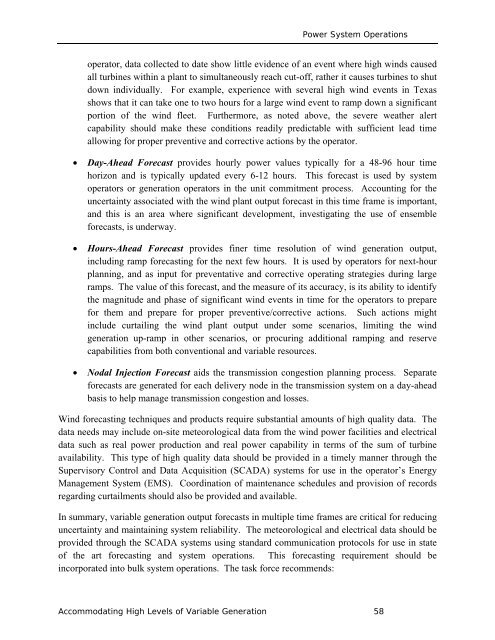Accommodating High Levels of Variable Generation - NERC
Accommodating High Levels of Variable Generation - NERC
Accommodating High Levels of Variable Generation - NERC
Create successful ePaper yourself
Turn your PDF publications into a flip-book with our unique Google optimized e-Paper software.
Power System Operations<br />
operator, data collected to date show little evidence <strong>of</strong> an event where high winds caused<br />
all turbines within a plant to simultaneously reach cut-<strong>of</strong>f, rather it causes turbines to shut<br />
down individually. For example, experience with several high wind events in Texas<br />
shows that it can take one to two hours for a large wind event to ramp down a significant<br />
portion <strong>of</strong> the wind fleet. Furthermore, as noted above, the severe weather alert<br />
capability should make these conditions readily predictable with sufficient lead time<br />
allowing for proper preventive and corrective actions by the operator.<br />
• Day-Ahead Forecast provides hourly power values typically for a 48-96 hour time<br />
horizon and is typically updated every 6-12 hours. This forecast is used by system<br />
operators or generation operators in the unit commitment process. Accounting for the<br />
uncertainty associated with the wind plant output forecast in this time frame is important,<br />
and this is an area where significant development, investigating the use <strong>of</strong> ensemble<br />
forecasts, is underway.<br />
• Hours-Ahead Forecast provides finer time resolution <strong>of</strong> wind generation output,<br />
including ramp forecasting for the next few hours. It is used by operators for next-hour<br />
planning, and as input for preventative and corrective operating strategies during large<br />
ramps. The value <strong>of</strong> this forecast, and the measure <strong>of</strong> its accuracy, is its ability to identify<br />
the magnitude and phase <strong>of</strong> significant wind events in time for the operators to prepare<br />
for them and prepare for proper preventive/corrective actions. Such actions might<br />
include curtailing the wind plant output under some scenarios, limiting the wind<br />
generation up-ramp in other scenarios, or procuring additional ramping and reserve<br />
capabilities from both conventional and variable resources.<br />
• Nodal Injection Forecast aids the transmission congestion planning process. Separate<br />
forecasts are generated for each delivery node in the transmission system on a day-ahead<br />
basis to help manage transmission congestion and losses.<br />
Wind forecasting techniques and products require substantial amounts <strong>of</strong> high quality data. The<br />
data needs may include on-site meteorological data from the wind power facilities and electrical<br />
data such as real power production and real power capability in terms <strong>of</strong> the sum <strong>of</strong> turbine<br />
availability. This type <strong>of</strong> high quality data should be provided in a timely manner through the<br />
Supervisory Control and Data Acquisition (SCADA) systems for use in the operator’s Energy<br />
Management System (EMS). Coordination <strong>of</strong> maintenance schedules and provision <strong>of</strong> records<br />
regarding curtailments should also be provided and available.<br />
In summary, variable generation output forecasts in multiple time frames are critical for reducing<br />
uncertainty and maintaining system reliability. The meteorological and electrical data should be<br />
provided through the SCADA systems using standard communication protocols for use in state<br />
<strong>of</strong> the art forecasting and system operations. This forecasting requirement should be<br />
incorporated into bulk system operations. The task force recommends:<br />
<strong>Accommodating</strong> <strong>High</strong> <strong>Levels</strong> <strong>of</strong> <strong>Variable</strong> <strong>Generation</strong> 58
















